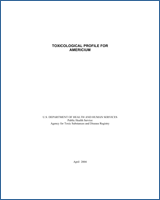NCBI Bookshelf. A service of the National Library of Medicine, National Institutes of Health.
Toxicological Profile for Americium. Atlanta (GA): Agency for Toxic Substances and Disease Registry (US); 2004 Apr.

Toxicological Profile for Americium.
Show detailsThe international, national, and state regulations and guidelines regarding americium in air, water, and other media are summarized in Table 8-1.
The USNRC maintains a database of information regarding licensees authorized to possess americium isotopes (241Am through 244Am) within the 18 non-Agreement States (states not committed to self-regulation). This database includes more than 2,000 records of licensees and site possession limits in the microcurie to curie range. The isotope, 241Am, accounts for most of the licenses. Such records for USNRC Agreement States are maintained by the individual state radioactive material regulatory organizations. The USNRC and EPA each have responsibilities for regulating the cleanup of radioactivity and decommissioning of USNRC licensed sites. USNRC and EPA reached an agreement in 2002, in response to Congressional mandate, to preclude double regulation of these efforts. The agreement provides that EPA will defer exercise of authority under CERCLA for the majority of facilities decommissioned under USNRC authority. It also contains provisions for joint consultation when certain EPA parameters are exceeded, including groundwater exceeding EPA-permitted levels, USNRC contemplation of restricted release or alternate release criteria, and residual soil radioactivity concentrations exceeding those in the agreement (USNRC 2002).
No inhalation or oral MRLs were derived for americium or americium compounds.
The EPA IRIS database has withdrawn its cancer classification for radionuclides, but the EPA Office of Air and Radiation believes that all radionuclides, including the americium isotopes, should be considered to be known carcinogens, and has assigned them to Group A. Carcinogenic toxicity values for 241Am are listed in EPA’s Federal Radiation Guidance Report No. 13 (EPA 2000a). Lifetime excess total cancer risk per unit intake are included for inhalation (Table 2.1), drinking water ingestion (Table 2.2), and submersion, ground plane exposure, and soil intake (Table 2.3) of EPA (2000a). Media-specific usage rates (Table 3.1) provide a means of adjusting the values to be compatible with specific population groups (e.g., tap water intakes range from a low of 0.188 L/day for a newborn female to a high of 1.643 L/day for a 50-year-old male, with a societal average of 1.11 L/day). The EPA has not derived reference concentrations (RfCs) or reference doses (RfDs) for americium (IRIS 2002), but has derived a maximum contaminant level (MCL) of 15 pCi/L for total alpha-emitters (including americium), less uranium and radon (EPA 2000c).
Table 8-1
Regulations and Guidelines Applicable to Americium.
- REGULATIONS AND ADVISORIES - Toxicological Profile for AmericiumREGULATIONS AND ADVISORIES - Toxicological Profile for Americium
- RELEVANCE TO PUBLIC HEALTH - Toxicological Profile for AmericiumRELEVANCE TO PUBLIC HEALTH - Toxicological Profile for Americium
- serine/threonine-protein phosphatase 4 regulatory subunit 4 isoform X1 [Danio re...serine/threonine-protein phosphatase 4 regulatory subunit 4 isoform X1 [Danio rerio]gi|528511540|ref|XP_005160668.1|Protein
- RNA for Nucleotide (Select 1786622296) (1000)Nucleotide
- Component(Core) Links for Nucleotide (Select 1700657527) (3)Nucleotide
Your browsing activity is empty.
Activity recording is turned off.
See more...